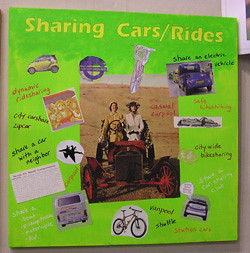Money may be taking the joy out of the ride.
It seems like ridesharing is all the rage right now. Articles in Time and Forbes have celebrated its spread, and the adoption of new rules to encourage ridesharing are being considered in cities from Seattle, to Austin, to Washington DC. Yet just last week, ridesharing service RideJoy announced that it was throwing in the towel, prompting one observer to ponder why ridesharing is taking off in Europe, but failing to gain traction in the US.
Sound like a contradiction? It's not, really. The truth is, there are two completely different phenomena going by the same name: "ridesharing." And one of them is cannibalizing the other.
Traditionally, ridesharing has meant just that -- two or more people, who were going the same way anyway, sharing a ride to get there. Drivers might sometimes receive some slight economic payback -- money chipped in toward gas, or a break on bridge toll. But the primary reason for engaging in ridesharing has long been what social psychologists call intrinsic reward -- that is, people share rides because sharing rides is fun and interesting, and because the more rides people share, the fewer cars are on the street, leading to less pollution and a better, healthier planet for all of us.
RideJoy was a web-enabled service for just this sort of ridesharing. Several successful ridesharing services have emerged in Europe, including Blablacar and Carma. However, in the US, most of the companies calling themselves "ridesharing" have pursued another, very different model. Companies like Lyft, Sidecar, and Uber depend on drivers who are paid for their rides -- much like taxicab drivers -- with the companies taking a percentage of each fare -- much like taxicab companies. Experience has shown that this for-profit version of ridesharing is effective at attracting drivers -- and perhaps even more importantly, investors. But there is a problem: payment for services constitutes an extrinsic reward which competes with, and can even erode, intrinsic motivation. Psychologists call this the overjustification effect, and it could be the nemesis of ridesharing.
Numerous studies have pointed to the erosive effect of extrinsic rewards. For example, children who enjoyed drawing were offered a reward for drawing; once the reward was no longer offered, they had less interest in drawing than they had had before the reward. Another study found that monetary payment reduced the number of voluntary female blood donors, because the extrinsic reward "crowded out" the intrinsic motivations for donating blood.
Education writer Alfie Kohn puts the problem this way:
...the more you use rewards to "motivate" people, the more they tend to lose interest in whatever they had to do to get the rewards. Extrinsic and intrinsic motivation not only are different, in other words -- they generally are reciprocally related: as extrinsic goes up, intrinsic most often goes down. (Kohn, Challenging Behaviorist Dogma)
(Note: You can view every article as one long page if you sign up as an Advocate Member, or higher).





